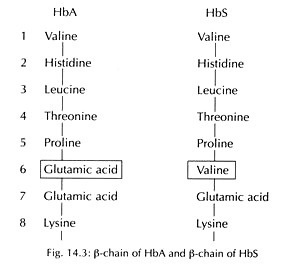Learn about the relationship between Gene and Enzyme.
An understanding of the relationship of the gene and the enzyme is crucial for an analysis of the basis of growth and development of an organism. It has been established through varied lines of evidences that genes control all hereditary characters of an organism, which are transmitted from generation to generation.
Simultaneously, it is also established that all essential biochemical pathways, responsible for the expression of the character, are controlled by the enzymes. It has been demonstrated that genetic control of all characters is mediated through specific enzymes. More precisely, the message of gene is ultimately carried out by the enzymes.
Just as every biochemical pathway is controlled by a gene, enzyme too responsible for every step in metabolism. Just as genes are specific for each and every character, enzymes too are specific for each step in metabolism. The difference between different genes is also reflected in the basic chemical differences of the enzyme which they control.
One Gene-One Enzyme Hypothesis:
Neurospora Mutants:
A wild strain of Neurospora crassa can synthesize all the amino acids essential for the formation of its protein.
Normally, this mould can grow in a ‘minimal medium’ containing sucrose, nitrate, minerals and only vitamin – biotin. However, if spores of wild strain are treated with a mutagen, some of the spores will be unable to grow on the minimal medium and will require the addition of some other substance, such as amino acid citrulline or vitamin niacin.
In a living system, the synthesis of organic molecules, such as amino acids, is termed biosynthesis. It entails in most cases a series of stepwise biochemical reactions, each catalyzed by an enzyme. The sequential reactions that lead to the synthesis of a given compound, such as arginine – constitute a biosynthetic pathway.
The cycle from ornithine to arginine can be summarized as follows:
Beadle and Tatum while studying on several mutant strains of Neurospora found that they were unable to synthesize arginine. Since there are different steps in the synthesis of arginine, a mutation at any one of them results in a block in arginine biosynthesis.
When each mutant type is crossed with a normal or wild type, the later progeny shows the inheritance according to a monohybrid ratio, indicating a single gene difference.
One class of mutant was found to grow on arginine or citrulline and also on ornithine. An arginine-requiring mutant that can grow in the presence of ornithine is able to carry out the reactions from ornithine through citrulline to arginine.
Therefore, a mutant of this type will also grow when given either citrulline or arginine. Obviously, gene mutation in this class of mutant results in a block in one of the reactions that precedes the synthesis of ornithine.
Similarly, a mutant that can grow in the presence of citrulline or arginine but not in ornithine, must be unable to convert ornithine into cirtrulline; and accordingly a mutant that can utilize only arginine must possess a block between citrulline and arginine. The evidence derived from examining the biosynthesis shows that each of the three mutant classes has lost one of the three different biochemical reactions.
A different enzyme is required for each of the steps in the biosynthesis of arginine. Therefore, the functional distinction between wild and mutant types, resides either in the loss of ability to produce one of the three enzymes essential for arginine biosynthesis or in the production of an altered enzyme. In this case, therefore, the relation between gene and enzyme is 1:1 (Fig. 14.1).
Inborn Metabolic Errors in Human:
One of the earliest investigations of biochemical mutations concerned with the metabolic disease of human known as alkaptonuria where the urine is black. This metabolic error is inherited as a recessive trait. The affected individuals are unable to metabolize a substance called homogentisic acid into acetoacetic acid, which in turn is excreted in the urine.
A single biochemical reaction is missing in alkaptonurics, for which they cannot convert homogentisic acid into acetoacetic acid.
Homogentisic acid is as such excreted in the urine and oxidized upon exposure to air causing the urine to become black. The chemical reaction by which homogentisic acid is converted to acetoacetic acid requires the presence of an enzyme that is either inactive or absent in alkaptonurics (Fig. 14.2).
One Gene-One Polypeptide Concept:
The ‘one gene-one enzyme’ hypothesis has been modified in several different ways. The gene forms a mRNA molecule which serves for coding of protein (enzyme). In some cases several genes form a single mRNA strand, which is then said to be polycistronic. As a single mRNA may lead to the production of several polypeptides from a single polycistronic structure, the recognized concept is one gene-one polypeptide.
This has been illustrated by the study of sickle cell anaemia in human beings, found specially in Negroes. The R.B.C. in this disease become sickle shaped owing to the lower concentration of oxygen. This causes rupture of cells and severe haemolytic anaemia. The molecular basis to this lies in the difference of arrangement of amino acid molecules in haemoglobin.
Haemoglobin is a protein, consists of four polypeptide chains – two identical a-chains and two identical p-chains. The sickle shaped haemoglobin (HbS) differs from normal haemoglobin (HbA) in the presence of valine in the place of glutamic acid at sixth position of one of the p-chain (Fig. 14.3).
Sickle cell anaemia is, therefore, produced by a single change in any one of the two β- polypeptide chains, caused by a single mutation in one gene, it means that one gene controls the synthesis of one polypeptide chain and not complete protein.



